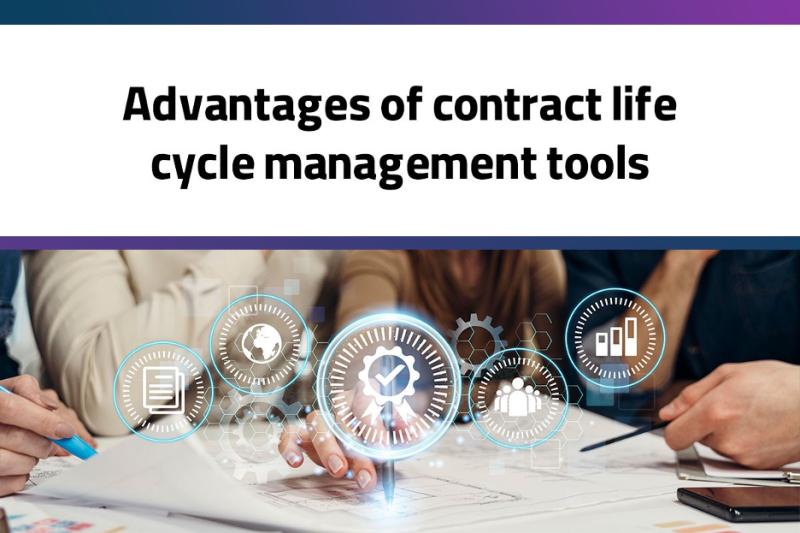Advantages of contract lifecycle management tools

Introduction
No matter the industry, contracts are essential to every firm. They control nearly every dollar that comes into or goes out of a business. The dynamics of the global business environment have changed so much that business models and the laws accompanying them now need more time and effort. Additionally, contracts are becoming more dynamic and contract administration more complicated due to the growing emphasis on compliance across all verticals.
Modern contract lifecycle management (CLM) technologies that assist companies in coordinating their legal activities with their commercial objectives are necessary in the current situation. The most fundamental information regarding the advantages of contract lifecycle management solutions is provided in this article.
What is Contract Lifecycle Management (CLM)?
Monitoring and controlling a contract's performance, compliance, and other success criteria at each point of the document's lifespan, from execution to renewal or expiry, is known as contract lifecycle management, or CLM. The proposal or request for a contract marks the start of the management process, which lasts until the promised item or service is delivered, and the contract is renewed. Organisations may reduce risk and improve the chance that significant contracts will function as intended by maintaining a disciplined approach to managing agreements. This is made possible by having a robust CLM procedure.
Companies develop or implement contract lifecycle management (CLM) systems, typically in contract management software, to help organise and streamline various aspects of the contract lifecycle. Every stage of the contract lifecycle can be handled with a contract lifecycle management tool, which usually includes features that assist legal teams in creating, collaborating on, negotiating, signing, tracking, and renewing contracts. This kind of contract tool is generally purchased when a company's contract volume grows to the point where handling them manually using Word and shared drives becomes challenging. While some CLM solutions offer a quick and cost-effective way to influence particular process steps, others are designed to address every aspect of the contract lifecycle. There is no one-size-fits-all CLM solution; instead, it is best to identify the software that best suits your particular needs because every business has different demands, budgets, and challenges. If you read until here, I guess you like this article, "Top best software for law firms."
Benefits of Contract Lifecycle Management Tools
Accelerated contract authoring
Contracts are legally binding documents, so they must be clear, concise, and accurate. Administrators can use a clause library with pre-approved language to create contract templates in modern CLM solutions. Using the power of pre-approved contract clauses and templates, even users with no legal expertise can draft contracts quickly by including the required field values, selecting clause language, and making minor tweaks to suit the current engagement.
In addition to reducing legal dependencies and costs, contract templates ensure language consistency across all contracts.
Furthermore, templates make it simple to implement organizational-wide policy changes. Admins can quickly update the clause library and ensure that the most recent language is used in all contracts.
Intelligent contract management software eliminates the need for human intervention during post-execution management stages like amendments and renewals. For example, when an amendment is made, the software automatically generates an amendment letter that includes all the changes made to the original contract and the contract history.
A CLM solution's real-time collaboration features also encourage peer review.
Having additional minds involved in contract authorship reduces the likelihood of mistakes. According to most legal teams, peer review while authorship also helps cut review cycle times during approval and negotiation.
Configurable approval workflows
Before a contract is finalised, approval protocols ensure that internal stakeholders are informed of the possible possibilities and hazards. Administrators may establish approval procedures, both sequential and parallel, using digital contract management platforms.
Contract owners can only execute a contract when the corresponding approvers approve it because approvals are automated. As comments, approvers can review the contract provisions and modify the document. Modern CLM systems' sophisticated capabilities, such as activity tracking at the approval level and timestamps, increase process efficiency and eliminate delays.
One of the critical advantages of approval procedures is that they give improved insight into contract risks at the individual contract level, allowing administrators to develop granular risk-mitigation methods.
Reduced negotiation cycles
Contract negotiation is an essential component of contract management. The contract lifecycle negotiation process allows firms to reach favourable terms and establish the tone of their commercial partnerships.
Traditionally, businesses negotiate by sending contract documents back and forth as email attachments until both sides agree on the terms. The stakeholders enter, remove, and amend contract terms during this procedure. Organizations confront various operational issues when negotiating over several email threads, making it challenging to manage the negotiation state and precisely find changes.
A CLM system avoids the tedium of emailing back and forth and encourages shorter negotiation cycles. Contract owners can use one to securely distribute contract papers by granting proper access permissions to each negotiator. The counterparties can cooperate in real time to make changes to the document and offer comments.
A CLM system also includes seeing the negotiation history and comparing document versions. The CLM mentioned above software functions, along with powerful analytics, enable firms to obtain insights and reassess their negotiating methods.
Fast contract execution
For contract execution, most contract management software includes a native e-signature solution or third-party connectors. Contract owners may now skip the email, print, sign, and fax processes and have their contracts signed in minutes.
Contract owners can also specify signing orders and customise procedures for each contract. By decreasing signature delays, CLM software facilitates simple and quick onboarding of vendors, workers, clients, and counterparties.
Because of their ease, e-signatures are increasingly becoming popular and permeating many industries. The ESIGN Act of 2000 addresses electronic signing as the most secure, convenient, and dependable method of contract binding.
Contract renewal management
Even though contract renewal is still a low-hanging fruit for recurring sales, many organisations still need to meet renewal deadlines. These missed renewals result in lost income and business prospects. A lack of automatic warnings frequently causes missed deadlines and chances.
You will never miss contract milestones or renewal chances if you use a digital contract management solution with automatic in-app and email alerts. It allows users to keep ahead of any upcoming deadlines and plans.
Furthermore, CLM software enables contract management teams to analyse contract performance across several dimensions, such as income earned, and responsibilities met within the contractual time. This assessment allows legal teams to make educated contract renewal choices. Maintaining current business contacts proactively will open doors to more significant and considerable prospects.
A Note on Security
Contracts frequently includes sensitive information, so security issues should be prioritised when selecting how and where to keep and arrange your contracts. At a minimum, your contract data must be encrypted in transit and at rest. Even if an unauthorised person gained access to one of your contracts, the information would be rendered illegible.
Two-factor authentication is another crucial security feature to consider when selecting CLM software for your firm. Logging in needs a username and password and an extra security precaution, which often entails entering a one-time login code texted to your mobile device. Other potential safety aspects to consider are:
- Disable printing options
- Audit logs (used to trace who has viewed or altered documents)
- Access control using permissions management
- Blind for privacy
In case you're ready for the advantages of contract lifecycle management but without the lengthy delays and hidden costs, visit the LegaMart directory to find out how LegalMart can help your business manage.
Conclusion
Contract managers frequently describe their employment as "challenging." CLM may reduce stress by establishing an organised procedure for each task, increasing efficiency and output.
Furthermore, contract lifecycle management reduces liability, increases cost savings, and improves delivery quality and business partnerships. The outcomes are tangible, quantifiable, and long-term. Contract management expenses are rising, as are demands for accountability, good governance, and transparency, indicating that understanding and automating an organisation's CLM is a must-do initiative.
More to Read:
Previous Posts:
Next Posts:



